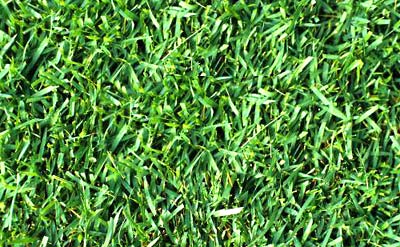Source(s): Jacob G Price
St. Augustinegrass is becoming increasingly popular in Georgia landscapes. This turf is susceptible to several insect and disease problems that occur in Georgia. Treatments for each situation are often very different so correct diagnosis is important before choosing a treatment option.
Chinch Bugs and Take-All Disease: (Fig. 1). Take- All Disease kills large areas of turf. Stolons, grass blades, and roots die, leaving turf that is easily pulled up. Roots are dark brown, and dark lesions are sometimes seen on stolons. (Fig. 2). Take-All Disease is usually associated with a pH of 6.3 or above at the soil surface. Incidences of Take-All Disease are increasing in Georgia. Chinch Bugs and Take-All Disease are the two most serious problems in St. Augustinegrass. (Fig. 3). Mature Chinch Bugs are about 1/8” long. Nymphal stages are reddish in color. If suspected, the fast moving insects can be found in thatch or on blades of grass in sunny areas of the lawn. The first symptoms of Chinch Bugs are yellowing of individual blades of grass which quickly becomes large brown areas.
 Other Insects and Diseases: Brown Patch damages grass in circular patterns that enlarge to 8′. At first the area appears sunken. Excess moisture, high nitrogen fertilizer, and temperatures between 70-85 degrees, usually precede the outbreak. Gray Leaf Spot appears as tiny gray to brown spots on blades of grass usually in shaded areas with high moisture. Over-all appearance is irregular thinning of turf. Fairy-Ring is a disease that first appears as a lush green circle or semi-circle that moves outward with potential to leave bare areas of turf behind. Fairy-ring fungi often occur where roots or buried debris are decaying. Mushroom circles often appear in the fall. Mole Crickets are insects which feed on and sever roots which gives turf a spongy feel. Large irregular areas may die. They can be detected by pouring 1 gallon of water mixed with 2 tbsp of dishwashing liquid over the borders of the infested area. Sod Webworms and Fall Armyworms can also be detected with soap and water. The worms leave chewed edges on grass blades and can eat the grass to the ground. White Grubs are larvae of several types of beetles. Detection requires digging a square foot section to a depth of 4 inches and counting grubs. Treatment depends on the number and species detected. For more information and control options contact your local county extension office.
Other Insects and Diseases: Brown Patch damages grass in circular patterns that enlarge to 8′. At first the area appears sunken. Excess moisture, high nitrogen fertilizer, and temperatures between 70-85 degrees, usually precede the outbreak. Gray Leaf Spot appears as tiny gray to brown spots on blades of grass usually in shaded areas with high moisture. Over-all appearance is irregular thinning of turf. Fairy-Ring is a disease that first appears as a lush green circle or semi-circle that moves outward with potential to leave bare areas of turf behind. Fairy-ring fungi often occur where roots or buried debris are decaying. Mushroom circles often appear in the fall. Mole Crickets are insects which feed on and sever roots which gives turf a spongy feel. Large irregular areas may die. They can be detected by pouring 1 gallon of water mixed with 2 tbsp of dishwashing liquid over the borders of the infested area. Sod Webworms and Fall Armyworms can also be detected with soap and water. The worms leave chewed edges on grass blades and can eat the grass to the ground. White Grubs are larvae of several types of beetles. Detection requires digging a square foot section to a depth of 4 inches and counting grubs. Treatment depends on the number and species detected. For more information and control options contact your local county extension office.
| March | April | May | June | July | August | September | October | |
| **Chinch Bugs |
x
|
x
|
x
|
x
|
||||
| **Take-All Disease |
x
|
x
|
x
|
x
|
x
|
x
|
||
| Brown Patch |
x
|
x
|
x
|
x
|
||||
| Gray Leaf Spot |
x
|
x
|
x
|
|||||
| Fairy Ring |
x
|
x
|
x
|
x
|
x
|
x
|
x
|
x
|
| Mole Crickets |
x
|
x
|
x
|
x
|
x
|
x
|
||
| Sod/Fall Armyworms |
x
|
x
|
||||||
| White Grubs |
x
|
x
|
x
|
x
|
x
|
x
|
**Very serious and must be dealt with as soon as detected.
Resource(s):
Turfgrass Diseases
Turfgrass Diseases: Quick Reference Guide
Center Publication Number: 244
- Growing Asparagus: A Luxury Vegetable - September 24, 2013
- Frizzle Top in Sago Palms - September 24, 2013
- Growing Onions in the Home Garden - September 24, 2013
